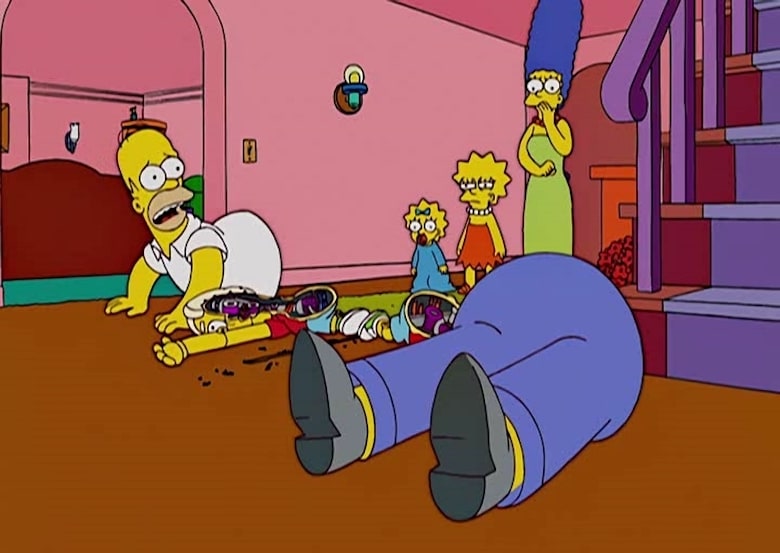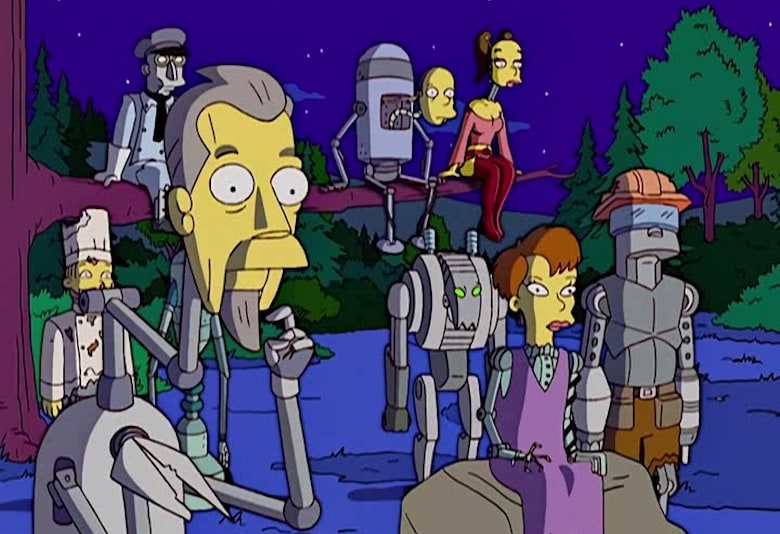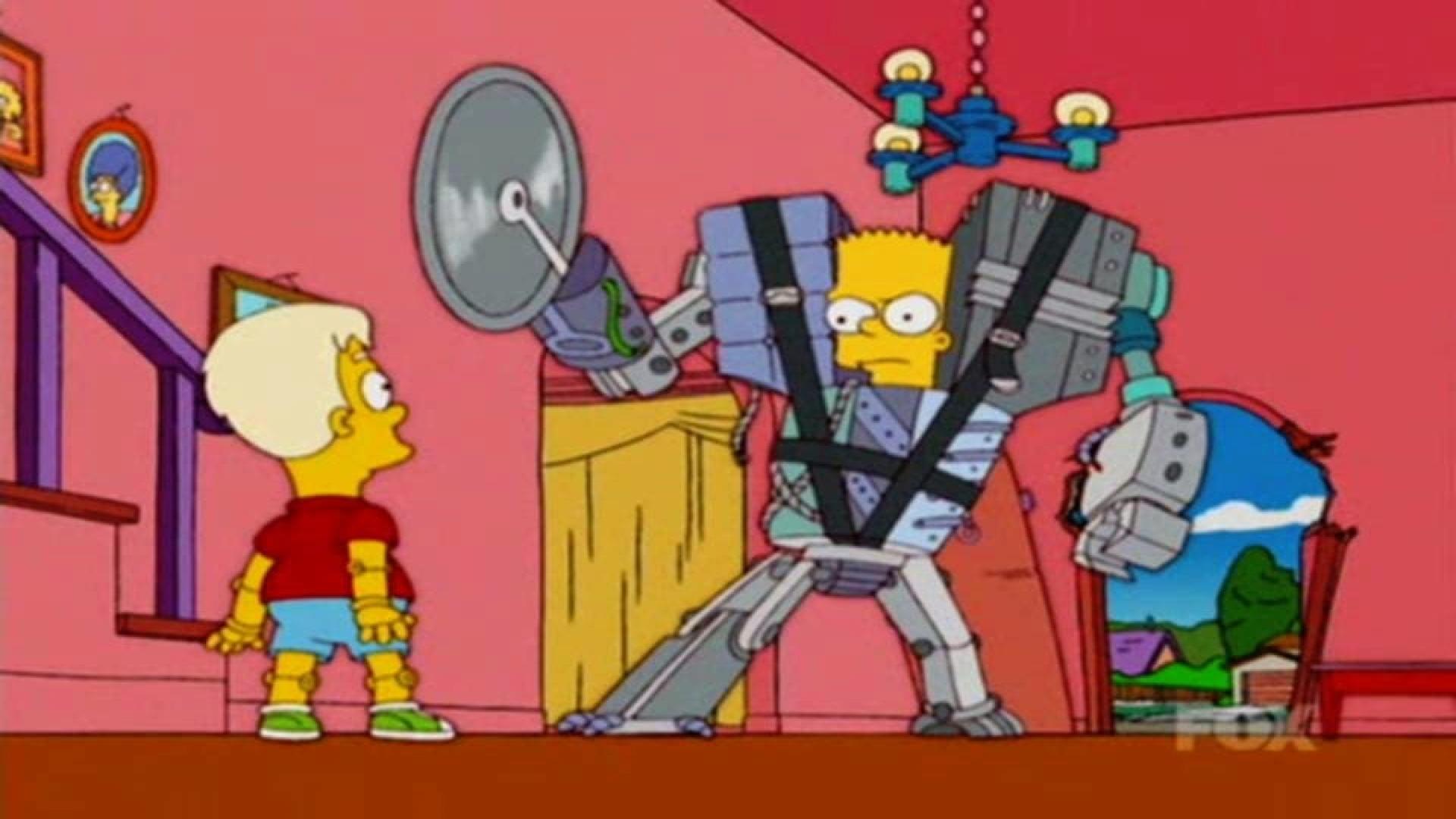It’s said that The Simpsons has predicted pretty much everything. Terrorist attacks, autocorrect, Trump’s presidency; you name it, The Simpsons made an episode about it before it happened. The show definitely has an uncanny way of being clairvoyant, but very few of their Halloween-themed Treehouse of Horror episodes actually deal with the future. “B.I. Bartificial Intelligence” is an exception to that rule.
Okay, I’ll be fair: “B.I. Bartificial Intelligence” is undoubtedly just a parody of Spielberg’s 2001 sci-fi flick A.I. Artificial Intelligence. That means that the segment didn’t really do all that much prediction. But it is still one of the rare Treehouse of Horror mini-episodes to parody sci-fi rather than horror.
Despite the source material for “B.I. Bartificial Intelligence” not being a horror movie per se, the segment still features a humorous take on multiple tropes from the genre. It also shows how sci-fi naturally intersects with horror through our own fears of technology, (b)artificial intelligence, and the future.
Summary of “B.I. Bartificial Intelligence”
The basic idea behind “B.I. Bartificial Intelligence” is very similar to that of the movie that it is based on. The actual plot, though, is pretty different. It also doesn’t retain much of the social critique of Spielberg’s film. Rather than advanced A.I. being a part of the world due to global warming, Springfield has intelligent robot children… just because.
Oh well, we don’t need much of an explanation for these episodes anyway.
It begins with Bart trying to show off to a disinterested Lisa. He posits that he could jump from their window into the pool, several stories below. Lisa replies that it would be stupid; Bart goes for it. Naturally, he misses, and he is in a vegetative state due to his injuries. Man, some of these Treehouse of Horror segments sound pretty dark once you remove the cartoon aspect.
The family is struck with grief, but they are introduced to a possible solution: an A.I. powered robotic child. They jump on the idea to deal with Bart no longer being a part of their lives, and they quickly become accustomed to him as a part of the family. Homer in particular loves the kid. It helps that he’s able to turn his face into a waffle iron.
Meanwhile, Bart suddenly wakes up from his coma while his family forgets about him. He returns home to find that he has been replaced, and things get hectic. They eventually decide that there isn’t room for a metal boy and a flesh boy at the house, so they get rid of one of them by dropping him off in the woods. Sadly for El Barto, it’s not the robot who gets sent away.
Bart then has to find his way to safety. While pacing through the woods, he discovers a band of ragtag robots who were abandoned just like him. He sleeps with them for the night, and he decides to take advantage of their trust by pilfering their parts while they’re powered down. When they awake, they discover that their mechanized bodies have been looted… but Bart is nowhere to be found.
The Simpson family, happy to have peace with their preferred son at last, is shocked when Bart returns. To be more specific, they’re shocked when the new Bart returns: he has upgraded his body with his stolen robot parts, turning him into a grotesque cyborg. He kills his fully robotic counterpart… but he chops Homer in half in the process.
Luckily, things mostly end well. The hulking, rickety cyborg Bart has retaken his place in the family… and Homer’s body is fitted with the robot boy’s legs so that he can live once more. Sadly, the puny limbs can’t support Homer’s particularly robust frame. Cybernetics can’t fix everything, it seems.
Trope 1 – Fear of Technology
The main trope that is being played on in this segment – as well as in the source material – is the fear of technology. It’s a theme that we see throughout both horror and science fiction. It’s rare to see a sci-fi flick where advanced technology results in a perfect utopia without any problems, and there are a number of horror movies where tech becomes a major threat.
In fact, the fear of technology is a trope that is presented in a few different ways in horror movies. One of the most common is a fear of artificial intelligence. While A.I. might sound like a godsend, writers are acutely aware of just how terrifying the prospect of a truly intelligent robot is.
A movie like 2001: A Space Odyssey, despite not technically being a horror movie, is a perfect early example of this. In 2018’s Upgrade the idea takes a step further by seeing what would happen if evil A.I. were to be implanted in our own bodies.
But it doesn’t need to be just A.I. that we are afraid of. Horror movies have used all sorts of technology as villains. Sometimes it is the tech itself that is scary, but other times it is how the technology can be used by bad people. Think Frankenstein … or even modern semi-equivalents like Unfriended. (Sorry, Mrs. Shelley.)
In “B.I. Bartificial Intelligence,” this fear is laid out pretty clearly – and in a very classic way. A new piece of technology is introduced that seems like it could really improve all of our lives. By the end of the segment, the tech breaks apart their family and nearly results in Homer’s murder. As silly as it is, it’s actually a timeless – and quite prescient – tale.

The fear of technology isn’t just something relegated to the world of sci-fi and horror. Treehouse of Horror (as well as countless other books, TV shows, and movies) played upon this fear because it is somewhat inherent in the human psyche. As Discover Magazine notes, we are afraid of things that are new and unfamiliar. Pieces of new tech are always going to frighten us at first because of the way they might change our lives. Our overactive imaginations can turn everything from self-driving cars to forks into terrifying catalysts for catastrophe.
And hey, maybe our technophobia is a survival mechanism. The human penchant for advancement and growth has led us to things like climate change and nuclear warfare. New tech makes us imagine doomsday scenarios, and some of them aren’t that unrealistic. Maybe we really should have just stopped inventing new things after we came up with the fork.
Trope 2 – Impostors
Another major horror theme that “B.I. Bartificial Intelligence” plays with is that of the impostor. And before you start making Among Us jokes, hear me out. The idea of a sinister doppelganger is one that has been important in horror throughout the ages.
In this particular Treehouse of Horror segment, Bart awakens from a coma to find that his world has been completely changed. (That in and of itself is an effective horror trope as well. 28 Days Later, anyone?) When he returns home, the robot that has taken his place is like a mirror version of himself that reveals his insecurities. The robot is more well-behaved, more useful, and more easy to love. It’s just like him… but better. Is there anything more terrifying than that?
No, not really. And not to go all psychoanalysis again, but we are one of the few self-aware species, and this sense of identity is quite fragile. Psychologists point out that “a replication of the self undermines our sense of reality and who we are.” That’s why we are so frightened of imposters – and why “B.I. Bartificial Intelligence” feels scary despite not being based on a horror movie.
— FOUNDATIONS OF HORROR —
Further explore these subgenres & tropes. more>>
#Body horror | #Comedy horror | #Technology is Scary | #Creepy Twins | #The Simpsons

This is also why horror media has used the idea of an imposter – or a doppelganger, if you prefer – to such great effect. There are lots of amazing movies that create an uncanny atmosphere through the use of doppelgangers, with Us and It Follows being some of the finest examples in recent years. Whether it is an actual Creepy Twin or some kind of other doppelganger situation, the idea is used in horror often. For good reason.
Digging further will reveal that doppelgangers are a mainstay of horror, both in film and literature. The Strange Case of Dr Jekyll and Mr Hyde confirms the existence of this trope from more than 100 years ago, and films like Invasion of the Body Snatchers show that early filmmakers were eager to use the idea of a doppelganger for its ability to terrify.
The fear of an impostor is one that has been exploited in various media for a while, and it’s a phobia that’s deeply human. If I were in Bart’s position, I would be pretty ticked off too. Maybe not enough to cut my dad in half, but hey, can you blame him?
Trope 3 – Body Horror… and Possession
The fun part about the Treehouse of Horror series is that each segment is like a treasure trove of inside jokes for horror fans. You can appreciate it without any of the analysis that I’m doing here, or you can dive deep in and try to pick out all the winking details that the writers included. “B.I. Bartificial Intelligence” uses tropes to move the plot along, but it also includes a few quick gags that dig at horror cliches.
The first that I’d like to discuss is that of body horror. Interestingly, body horror was already parodied in a different Treehouse of Horror segment based on Cronenberg’s The Fly, so it’s clear the writers understand just how important of a trope it is to the genre. In “B.I. Bartificial Intelligence,” there are several instances that would be supremely nauseating if they were done with practical effects rather than cartooning.
For example, the robots that Bart runs into in the forest. They aren’t that terrifying, but their mixture of human characteristics and decaying robotic parts is pretty unsettling if you stop and think about it. It’s like something out of Videodrome. The same goes for Homer’s body with the tiny robot legs attached. When they collapse under his weight and leave him as just a torso with wires attached, I feel a tiny bit sick. Just a tad. A smidge.

Body horror is effective for a lot of reasons, but I like it in this episode because it works within the confines of the sci-fi setting. Yes, Bart’s massive cybernetic body culled from stolen parts is weird, but it shows it’s just another example of how technology might harm us in the future. If we start to adopt metal and chips as parts of our bodies, will we lose our identities as humans? Will our families even recognize us anymore?
Finally, I’d like to quickly discuss the closing gag of the segment. Right before it ends, Homer wakes up and realizes that it was all just a dream. Lisa assures him that none of it was real, and that his only real worry is the fact that he’s possessed by the devil. He then twists his head around a la The Exorcist and climbs on the ceiling. When Marge says he doesn’t need to go into work, he gleefully jumps back into bed and starts snoozing… with his head still on the wrong way.
It’s a hilarious little coda, and it’s a pretty well-done imitation of the overused exorcism scenes that have plagued horror since the 70s. There’s not much analysis that needs to be done here… it’s just funny.
While “B.I. Bartificial Intelligence” isn’t as creative as some other Treehouse of Horror segments, and it isn’t as suited to the classroom as The Simpson’s take on The Raven, it’s still a great parody of tropes that appear in both science fiction and horror. And it also has a lot to say about the human condition and what we are naturally afraid of.
But beyond that, you’ve gotta love it for one reason alone: nothing beats a joke about peeing on a Urinal-Bot. (Er, sorry, Lavotron.)
Last Updated on March 6, 2022.

